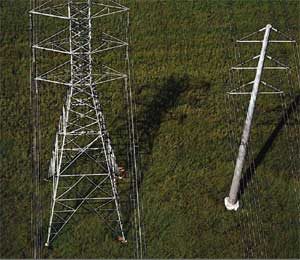Bulk Transmission = High Voltage Lines
The majority of major transmission lines in the U.S. are either 230-kilovolt (kV) or 500-kV alternating current lines. In some cases, 115-kV lines are used. Lower voltages are far less efficient for moving electricity across hundreds or thousands of miles to where it is needed without losing a significant amount of energy.
For safety reasons, the higher the voltage, the more distance is needed between the conductors and other objects such as trees, buildings or the ground. Though it is largely dependent on the surrounding terrain and the voltage level of the transmission line, in general, overhead high-voltage transmission lines are typically at least 30 feet off the ground.
Tower Varieties
 For high voltage lines, there are generally two tower options for overhead transmission line towers – lattice steel and tubular steel towers.
For high voltage lines, there are generally two tower options for overhead transmission line towers – lattice steel and tubular steel towers.
Lattice steel towers are more prevalent and common, and they come in several familiar shapes and sizes. These can be supported by four concrete footings, or a combination of concrete footings and guide wires. The number of conductors going between each tower depends on whether the transmission line is single circuit (three wires) or dual circuit (six wires).
Tubular steel towers are relatively new; they consist of a single steel pole anchored into the ground. These can be more visually appealing than their lattice steel counterparts, although historically they have been more costly to construct and can result in increased maintenance costs and requirements.
Clearance Requirements
Clearance requirements relates to a few issues, primarily the height of the wires from the ground and other permanent structures, the distance that must be between two towers in a single transmission line (or the distance between towers from two or more separate transmission lines built within a single transmission corridor), and the proximity of transmission lines to roads and highways. These requirements are mandated by federal, state and (sometimes) local governments and the specific requirements are a function of exactly where the line and towers will be located.
Reliability Standards
Reliability standards are closely related to clearance requirements. In short, this means ensuring the lights will stay on in the event of a tower collapse of other major failure along the line.
Undergrounding
It is possible to bury transmission lines underground instead of building an overhead system connected by a series of steel towers, but there are tradeoffs and requirements for public safety and the environment. Beyond the increased cost of undergrounding transmission lines (10 to 30 times greater than overhead construction depending on voltage), the main issues are heat and environmental impacts.
When high-voltage energy flows through a conductor, resistance in the conductor generates waste heat (or transmission losses). The higher the energy transmitted, the more heat is generated. With overhead transmission lines, the air surrounding the lines acts as an insulator and absorbs this waste heat. In underground transmission lines other mediums must be used to dissipate this heat, which to-date has restricted the undergrounding of transmission lines to voltages less than 500-kV except for very short distances.
Another consideration of underground lines is the ground disturbance caused by the tunnels through which the transmission line runs. Instead of impacting the ground only at tower footings, underground transmission construction requires extensive excavation and can disrupt habitats or water resources. Additionally, access to the underground transmission line, which is needed for maintenance and repairs, requires construction of “vaults.” These vaults are typically 20′ x 30′ structures (roughly the size of an average living room) that must be buried in the ground every 750-1,000 feet where the conductors are spliced together. The environmental and land disruption impacts of undergrounding transmission lines can greatly exceed that of above ground transmission and are factors that are weighed in the planning process.
